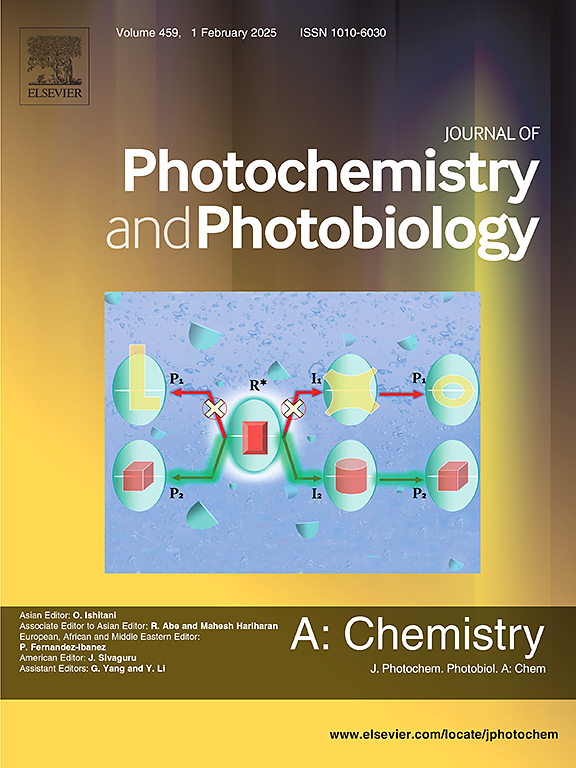用于水溶性溶解氧光学传感的Ru(II)基蓝色碳点键合探针:合成与性能
IF 4.7
3区 化学
Q2 CHEMISTRY, PHYSICAL
Journal of Photochemistry and Photobiology A-chemistry
Pub Date : 2025-05-21
DOI:10.1016/j.jphotochem.2025.116505
引用次数: 0
摘要
溶解氧浓度是生物研究和医学分析领域的重要分析物。本文采用水热法制备了蓝色发光碳点(CDs),并将其作为载体和参照物。三种带有三吡啶衍生配体的Ru(II)化合物与CDs共价结合,作为感应探针。合成的复合样品(Run@CDs, n = 1,2,3)通过形貌分析,XRD, IR和元素分析进行了分析和表征。最优样品(Ru3@CDs)表现出氧感特征,Ru(II)探针的发射带被溶解氧有效猝灭,而CDs的发射带对溶解氧不敏感。线性校准曲线为I0/I = 0.839 + 0.443*[O2], R2为0.998,响应时间为24 s,检出限为0.34 mg/L。Ru3@CDs对除H2O2外的常见干扰素均有选择性。用电子顺磁共振(EPR)方法证实了它的单线态产氧能力。本研究的新颖之处在于将Ru(II)探针的红色发射与CDs的蓝色发射相结合,使发射颜色由红色([O2] = 0.52 mg/L)变为蓝色([O2] = 40.01 mg/L)。本文章由计算机程序翻译,如有差异,请以英文原文为准。

Bonding Ru(II)-based probe with blue-emitting carbon dots for the optical sensing of aqueous dissolved oxygen: Synthesis and performance
The concentration of dissolved oxygen is an important analyte in the fields of biological research and medical analysis. In this work, the blue-emitting carbon dots (CDs) were synthesized through a hydrothermal method and used as a supporting host and reference. Three Ru(II) compounds with terpyridine-derived ligands were covalently bonded with the CDs and served as the sensing probes. The resulting composite samples (Run@CDs, n = 1, 2, 3) were analyzed and characterized by morphological analysis, XRD, IR, and elemental analysis. The optimal sample (Ru3@CDs) showed an oxygen sensing feature, with the emission band from the Ru(II) probe efficiently quenched by dissolved oxygen and the one from the CDs insensitive to dissolved oxygen. A linear calibration curve was fitted as I0/I = 0.839 + 0.443*[O2], with an R2 of 0.998, response time of 24 s, and LOD (limit of detection) of 0.34 mg/L. Ru3@CDs showed selectivity toward common interferents, except for H2O2. Its singlet oxygen generation ability was confirmed by the EPR (electron paramagnetic resonance) method. The novelty of this work was the combination of the red emission from the Ru(II) probe and the blue emission from the CDs, which resulted in the emission color change from red ([O2] = 0.52 mg/L) to blue ([O2] = 40.01 mg/L).
求助全文
通过发布文献求助,成功后即可免费获取论文全文。
去求助
来源期刊
CiteScore
7.90
自引率
7.00%
发文量
580
审稿时长
48 days
期刊介绍:
JPPA publishes the results of fundamental studies on all aspects of chemical phenomena induced by interactions between light and molecules/matter of all kinds.
All systems capable of being described at the molecular or integrated multimolecular level are appropriate for the journal. This includes all molecular chemical species as well as biomolecular, supramolecular, polymer and other macromolecular systems, as well as solid state photochemistry. In addition, the journal publishes studies of semiconductor and other photoactive organic and inorganic materials, photocatalysis (organic, inorganic, supramolecular and superconductor).
The scope includes condensed and gas phase photochemistry, as well as synchrotron radiation chemistry. A broad range of processes and techniques in photochemistry are covered such as light induced energy, electron and proton transfer; nonlinear photochemical behavior; mechanistic investigation of photochemical reactions and identification of the products of photochemical reactions; quantum yield determinations and measurements of rate constants for primary and secondary photochemical processes; steady-state and time-resolved emission, ultrafast spectroscopic methods, single molecule spectroscopy, time resolved X-ray diffraction, luminescence microscopy, and scattering spectroscopy applied to photochemistry. Papers in emerging and applied areas such as luminescent sensors, electroluminescence, solar energy conversion, atmospheric photochemistry, environmental remediation, and related photocatalytic chemistry are also welcome.

 求助内容:
求助内容: 应助结果提醒方式:
应助结果提醒方式:


